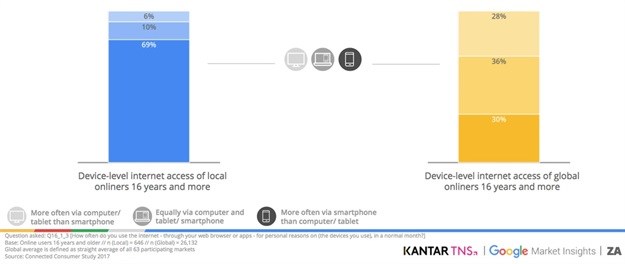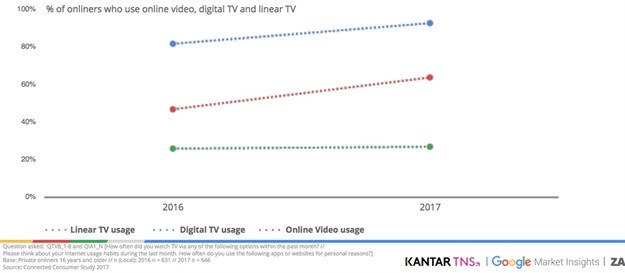Google SA has announced the launch of the 2017 Connected Consumer Study, conducted by research group Kantar TNS. This year's study researched how online behaviour has changed, compared TV and online video consumption habits, how mobile usage has evolved over time, and, finally, what the future of technology holds.

Image credit: Pixabay -
Pexels.
The study polled consumers 16 years and older across 63 countries in Q2 2017. In South Africa, people from all nine of South Africa’s provinces were interviewed, face to face, 60% in urban and 40% in rural areas.
You can view the full results of the study here.
Introducing the onliner
‘The onliner’ as such does not exist. Online is a medium of such immense reach that practically every target group can be found there. Onliners are often older than many may think intuitively, and many use the Internet several times a day. The internet is fun for online users, it is a daily-use digital tool and the first place to search for information. Despite the strong use and high importance of the Internet, many onliners still assess their own digital skills as either fair or poor. However, digital skills are increasingly becoming a key success factor in business and private life. The share of inexperienced users shows the high demand for digital training. Onliners recognise both the opportunities and the risks technology provides and they want to feel secure while using the internet as data protection is really important to them.
Internet usage on the rise
- 65% of 16+ South Africans are now online. This is up from 63% in 2016. South Africa is slightly ahead of the pack, when you compare with Nigeria, where internet usage is at 63% and in Kenya, at 53%.
Who is Online?
- Twenty-five million South Africans (16+ years old) access the internet locally for private purposes. The biggest demographic making up a third of the online population is aged between 25-34. The 35-44 age group has a 17% share, 20-24 at 15%, the 55+ at 15% and 16 -19 tie at 12%. The smallest group is 45-54 at 10%.
- When compared with the global online distribution, South Africa onliners are younger, with 60% of them aged below 35 years, versus globally where only 34% are below 35.
- Similar to the global distribution, South Africa’s online population is split 50:50 men and women.
- Going online is a daily habit - 65% of South Africans say they access the internet on a daily basis. Globally, daily access is at 87%. Even the 55+ use the internet frequently with 85% reporting that they access the internet daily.
How do they go online?
- Internet consumption is a mobile affair in South Africa, with 69% of polled consumers saying they more often access the internet on a mobile device, which is more than double the global rate of 30%.
- This is also seen across the age demographics:
What do they do online?
- Visiting social networks is the number one activity that South Africans say they do online. This is closely followed by using search engines and the third most frequent activity is watching online videos. Online is increasingly being used during purchase planning, as shown by the fourth activity - looking for product information.
Online Shopping is growing in popularity
- Online shopping has become a huge opportunity and is in itself a driver for internet usage.
- 2.5m South Africans shop online. This is only set to continue to grow.
The device ecosystem is also changing
- 60% of South Africans now use a smartphone. Smartphone usage has significantly grown from 47% in 2014 to 60% today. Though the use of basic mobile phones has been on the decline over the years, there was slight positive growth this year.
- Though TV usage is still huge, new technologies such as smart TVs and wearables are starting to penetrate the market.
How video behaviour has changed
- The traditional TV screen is today often surrounded by other connected devices, enticing people to go online while they watch TV - we call this screen stacking - which already quite a common activity. This screen stacking is not necessarily always additive as the vast majority of it is unrelated to what’s on the TV at that time.
- 30% of onliners report that they use TV as the only device to consume video. The rest access videos both online and on TV.
- The ecosystem of connected devices is growing, offering people more and exciting opportunities to enjoy video content across devices and platforms.
- While almost all onliners also consume video content on TV, online video consumption is also high at over 60%. Digital TV is still an emerging trend, with 20% of onliners consuming video on digital TVs.
What's the future of technology?
Growth in connected devices
- Globally, the number of connected devices per person is 2.9. In South Africa, this is 1.4.This means that for every 16+ person in South Africa (total pop), there are 1.4 connected devices. This is only growing - in 2014 the figure was 0.8.
- New technology such as wearables, smart speakers, VR headsets or apps on smart TVs now enrich the device ecosystem and start to penetrate the market.
Digital assistance
- Awareness of digital assistants is becoming apparent with 16% of South Africans saying they know of digital assistant products.
Closing
Internet usage is still growing and underlying developments such as a higher daily reach are stemming from increasingly mobile-centric internet access. The advanced ecosystem of connected devices is visible through the average number of those devices used per person. Connected devices affect how the Internet is used - mobile centricity affects almost all types of digital activity and shows that digital user satisfaction depends on a good mobile design.
In the future we can expect more connected devices, continued adoption of new technologies and the digital assistant becoming part of everyday life.





























